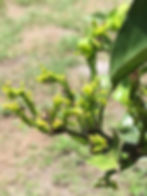
Dr. Ozgur Batuman | Plant Pathology Department | University of Florida Institute for Food and Agricultural Sciences Southwest Florida Research and Education Center, Immokalee FL

This page is under construction. Please check back later!
Common Florida Citrus Diseases
Below is a list of common pathogens that may affect citrus varieties around Florida.
Please consider submitting samples for diagnosis through the SWFREC Diagnostic Clinic if you suspect a problem.
Citrus Greening (Huanglongbing, HLB)
Causal Agent: bacteria, Candidatus liberibacter
Vector: Asian citrus psyllid (Diaphorina citri)
Symptoms: asymetric blotchy bottling of leaves with multiple shades of green, mishapen green fruits that do not ripen before falling prematurely.
There is also "green islands" sumptom where dark green areas get reduced to small dark green dots. Mottled leaves may be thicker and more leathery and have corky raised veins. Some of these syptoms ressemble zinc patterned deficiency. The difference is diseased trees have symptoms occuring in random manner, whereas nutrient issues happen uniformly.
Useful Links

ACPs transmit the HLB bacteria to all citrus varieties



ACPs transmit the HLB bacteria to all citrus varieties
Citrus Canker
Causal Agent: bacteria, Xanthomonas axonopodis pv. citri
Symptoms: Leaf lesions range from 2-10mm and have raised concentric circles on underside of leaf. They often have water-soaked margin and yellow halo. Yellow halo eventually changes to dark brown or black. Lesions always penetrate through both sides of leaf.
Fruit lesions are similar, 1-10mm in size, large lesions can penetrate a few millimeters into rind. Lesions may coalesce. Texture of lesion may include corky appearance and cracking as it ages.
Useful Links

citrus canker sumptoms on grapefruits

canker lesions and chlorosis on leaf


citrus canker sumptoms on grapefruits
Greasy Spot
Causal Agent: fungus, Mycosphaerella citri
Symptoms: foliar spots that appear yellow at first, with a slightly raised area on lower surface, and later these spots become brown or black, with a slightly "greasy" appearance
Useful Links



Citrus Black Spot
Causal Agent: fungus, Phyllosticta citricarpa
Symptoms: three main spot symptoms: virulent spot, cracked spot, hard spot. Virulent spot is small red spots, cracked is a thicker blister/scab like appearance, hard spot is the most typical symptom, appears usually around color change. All of these lesions range from 3-10mm in diameter. Younger lesions are small and reddish, with yellow halos. Foliar lesions are not as common as fruit symptoms.
Useful Links
IDTools Factsheet




Citrus Blight
Causal Agent: unknown
Symptoms: a "wilt-and-decline" disease of citrus
It can start as mild wilting and have a grayish hue in the foliage and have zinc deficiency symptoms.
The trees can then rapidly decline with twig dieback, off-season flowering, and small fruit.
It may be difficult to determine whether this citrus blight is the cause of the symptoms on a tree due to the widespread HLB and its extreme symptoms, and Citrus tristeza virus similarities.
The best ways to determine citrus blight diagnosis is 4 part:
1. High zinc content in trunk bark and wood
2. Presence of amorphous plus in the xylem
3. failure to absorb water injected into the trunk
4. presence of blight-associated citrus proteins in roots and leaves
Information from:


Citrus Leprosis
Causal Agent: virus, Citrus leprosis virus (CiLV)
Vector: Asian citrus psyllid (Diaphorina citri)
Symptoms: foliar and fruit lesions. Symptoms appear 1-2 months after mite vector inoculates. Typical lesions are circular with dark brown central mite feeding spot, 2-3mm in diameter. Feeding spot is surrounded by a chlorotic halo. Lesions may coalesce, and crack in high temperature conditions
Useful Links

ACPs transmit the HLB bacteria to all citrus varieties



ACPs transmit the HLB bacteria to all citrus varieties
Citrus Tristeza Virus (CTV)
Causal Agent: virus
Vector: Aphid
Symptoms: various symptoms and often asymptomatic. The most distinct ones are quick decline, stem pitting, and seedling yellows.
Useful Links

ACPs transmit the HLB bacteria to all citrus varieties



ACPs transmit the HLB bacteria to all citrus varieties
Brown Rot
Causal Agent: fungus, Phytophthora nicotianae or Phytophthora palmivora
Symptoms: rotting appears on mature or nearly mature fruit, starts with leathery lesions that may have water-soaked appearance. They are olive brown, have an odor, and may turn soft from secondary infections. Sometimes infection spreads to twigs, leaves, and blossoms.
Environment: when conditions are cool and wet, and to fruit closest to the ground because phytophthora spores are splashed from soil during rainstorms and infections develop under continued wet conditions.
Useful Links



